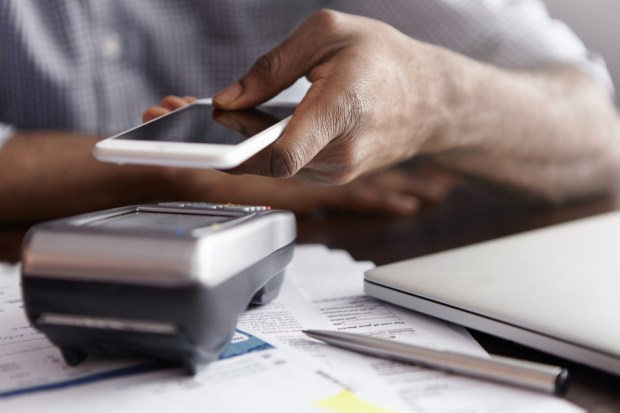WePay’s Aberman: It’s Time For POS Dinosaurs To Die Out

When it comes to the topic of future proofing, WePay Co-founder Rich Aberman told Karen Webster for this week’s edition of Unscripted Podcast, one should take all claims with an appropriate grain of salt. Depending on how long of a view one takes, the future will eventually find ways to turn left unexpectedly.
But, he said, when it comes to the point-of-sale (POS) and future-proofing, an extremely important sea change has taken place. Those in the POS business are now designing around the certainty of an uncertain future – and making sure to layer in enough “agility and flexibility” so that the products are designed to adapt toward things the designers can’t see.
Which, Aberman noted, is a massive departure from what a POS system was 10 or 15 years ago, when they weren’t designed to be future-proof, or really even designed to be a single thing.
“What people had were these Frankenstein configurations made up of the hardware, the software and the core payment functions – and all of those things were decoupled, Aberman said.
These things weren’t future-proofed individually or in tandem – and were plainly non-extensible into the modern omnichannel retail that sprouted up.
“The simple software running on the terminal didn’t contemplate the time when retailers would have a physical store and an online presence – or that those two channels would share inventory,” Aberman pointed out. “The hardware was unable to support a new payment type when EMV came around. Major retailers would have to integrate into separate acquirer stacks when they wanted to expand online – even if they were working with the same payment company.”
And while perfect future-proofing is something of an impossible dream, the makers of POS systems in the modern era understand that by integrating into a bundle and moving away from the “Franken-POS,” they can get smarter and have a greater appreciation for how fast things are moving and how many known unknowns there are.
And it’s a move, he said, that is simply becoming inevitable as time goes on and as the nature of retail is shifting.
Time for the Dinosaurs to Die
The biggest advance the point-of-sale is making from a merchant’s point of view, Aberman told Webster, is that the backend really isn’t their section anymore. Their concern isn’t how they are going to wholly upgrade their hardware or reset all of their systems in the event of a major change, because the goal is actually to take that off their plate entirely.
“If you look at Square or Stripe or WePay,” he noted, “they aren’t worried about the changes, because the tech firm is there to do all of those hard things on the backend, so the merchant avoids a lot of upheaval.”
What WePay likes about its place in the market, Aberman said, is that they are mostly working with small and medium-sized businesses that can just start with new POS systems. They aren’t working through legacy systems controlling single locations with 50 terminals. Small ships, he noted, can turn easily.
Big ships – like enterprise-size retail systems – turn very, very slowly, and with a lot of effort. But turn they will, Aberman noted, because they have to. The other option is sinking.
“There is a huge market out there for taking those major retailers that want a more agile integrated presence. And I think we might be looking at five to 10 years to fully migrate them over – but they absolutely have to figure out those migrations, because if they don’t, they die.”
How those transitions – massive and small – are going to happen, according to Aberman, still needs to be sorted out. But ultimately, he said, the future in this case will be a familiar story to anyone who knows the history of evolution: “The best products and solutions will win out, and the dinosaurs are going to die out.”
Which is not to say it’s a zero sum game, because Aberman believes this isn’t a fight to the death for a set amount of resources – it’s about which players are going to grow the pie and take best advantage of that growth.
The Grocery Example
The Amazon/Whole Foods story is an interesting case in point there, noted Aberman. Amazon brought on Whole Foods because it wanted to be to grocery what it is to the rest of commerce: a powerful agent of change.
And, he continued, there are two outcomes easily foreseeable down the path, and both are winning outcomes for Amazon. Either they take the Whole Foods brand so they can have that trusted name in grocery and the grocery supply chain, including the stores, and will build that brand in a way that allows the physical grocery store to “fade out over time.”
Or, they look at grocery and see it as a segment where the physical channel is always going to be a central part of the experience for most shoppers, and use that to build and expand their emerging multi-channel retail brand.
“For Amazon, either outcome of this test is a winner – and they have the kind of time scale necessary to really let these tests play out and use that to inform how they tweak their experiences,” said Aberman.
But while that might sound like just another forecast for how Amazon will soon be the only retailer, Aberman thinks that is a mistakenly zero-sum game approach to the issue. There are going to be a lot of innovations that pop up, brought into the market by Amazon or by the many heavyweights competing in grocery – and that is going to grow the pie by improving the experience with things like cashier-free checkouts, easy-to-scan QR codes and better loyalty offerings.
“This stuff might take years – but I think if we fast-forward a decade, we can’t even imagine the kinds of cool things they are going to create,” said Aberman.
Keeping Up With the SMBs
What is striking when one talks to smaller retailers and businesses, Aberman told Webster, is that they don’t often complain about needing more third-party apps to plug into. What they need, he said, is for the stuff that they have to work, and work well, together.
And the modern POS companies, he noted, have actually taken that to heart over the last few years – so whether one is using a native or third-party application, they have something that is compatible far more often than not.
“I’m not going to say this is universal yet – but I think we are getting there.”
And that means the story of the POS for the SMB is a much richer story about capabilities – things like loyalty, or order ahead, or mobile check-ins. These are things that SMBs are increasingly getting out of the box, with the expectation that they will just work.
Which means, Aberman said, a big part of the sea change in the last decade is that the questions providers like WePay and their competitors are asking themselves internally are changing a bit, too.
These days, he noted, one can look at the crazy amount of infrastructure rebuilding, and the equipment costs that major retailers are taking on, just so they can support something like EMV or contactless payments, or a buy-online, pick up in store platform. These are campaigns that cost billions.
Meanwhile, the coffee shop on the corner is getting all of those things by flipping on their point-of-sale device and paying $30 a month. And, Aberman noted, the $30 SMB version probably works a bit better.
“We used to wonder how we would give SMBs the power of the enterprise. Now, we wonder how anyone can give enterprise the simplicity and low cost of the SMBs.”
